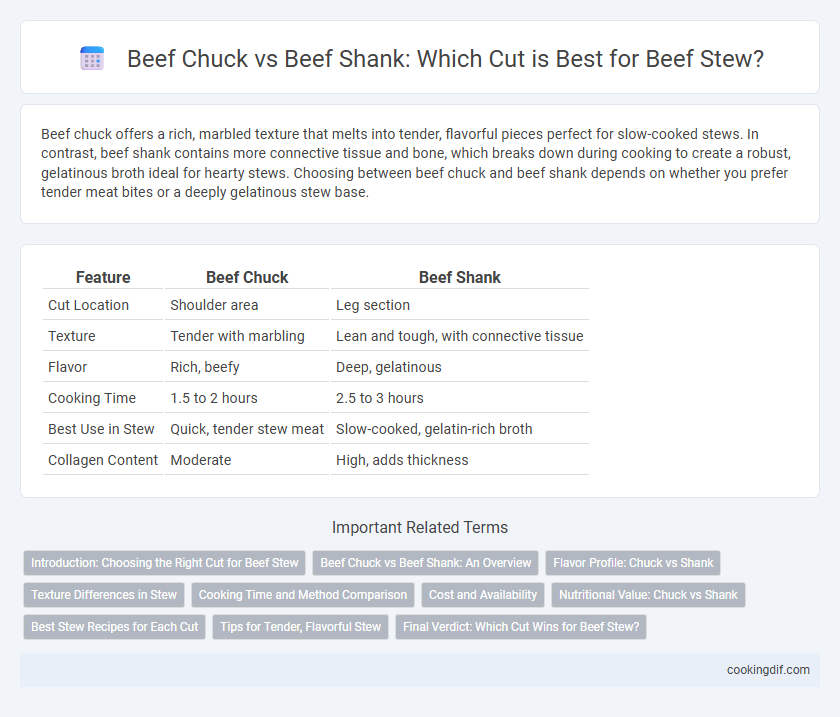Beef chuck offers a rich, marbled texture that melts into tender, flavorful pieces perfect for slow-cooked stews. In contrast, beef shank contains more connective tissue and bone, which breaks down during cooking to create a robust, gelatinous broth ideal for hearty stews. Choosing between beef chuck and beef shank depends on whether you prefer tender meat bites or a deeply gelatinous stew base.
Table of Comparison
| Feature | Beef Chuck | Beef Shank |
|---|---|---|
| Cut Location | Shoulder area | Leg section |
| Texture | Tender with marbling | Lean and tough, with connective tissue |
| Flavor | Rich, beefy | Deep, gelatinous |
| Cooking Time | 1.5 to 2 hours | 2.5 to 3 hours |
| Best Use in Stew | Quick, tender stew meat | Slow-cooked, gelatin-rich broth |
| Collagen Content | Moderate | High, adds thickness |
Introduction: Choosing the Right Cut for Beef Stew
Beef chuck and beef shank are popular choices for beef stew, each offering distinct textures and flavors. Beef chuck provides tender, well-marbled meat that breaks down into juicy, flavorful pieces, while beef shank delivers a rich, gelatinous consistency due to its high collagen content. Selecting the right cut depends on whether you prefer a melt-in-your-mouth texture or a hearty, rustic stew with a deeper, beefy taste.
Beef Chuck vs Beef Shank: An Overview
Beef chuck and beef shank differ significantly in texture and flavor suitability for stews, with chuck offering a tender, well-marbled cut that breaks down easily to create a rich, flavorful broth. Beef shank features more connective tissue and a denser muscle structure, requiring longer cooking times to become tender but imparting a robust, gelatinous quality to stews. Choosing between beef chuck and beef shank impacts stew consistency, mouthfeel, and overall heartiness, depending on desired preparation and cooking duration.
Flavor Profile: Chuck vs Shank
Beef chuck offers a rich, intense flavor with a good balance of marbling that melts into the stew, creating a deeply savory and succulent taste. Beef shank provides a more robust, slightly gamier flavor, with a leaner profile that imparts a hearty, beefy essence enhanced by its high collagen content. Choosing chuck results in a tender, juicy stew, while shank adds a distinctive depth and thickness to the broth through its connective tissues.
Texture Differences in Stew
Beef chuck offers a tender, succulent texture in stews due to its higher fat marbling and connective tissue that breaks down during slow cooking, creating a rich and juicy bite. In contrast, beef shank has a denser, more fibrous texture with significant collagen, resulting in a slightly chewier stew experience that thickens the broth. Choosing between chuck and shank depends on whether a softer, melt-in-the-mouth texture or a heartier, gelatinous consistency is preferred in the beef stew.
Cooking Time and Method Comparison
Beef chuck and beef shank both excel in beef stews, but they differ significantly in cooking time and method. Beef chuck, rich in marbling and connective tissue, softens beautifully with slow braising over 2 to 3 hours, yielding tender and flavorful meat. In contrast, beef shank requires longer cooking, typically 3 to 4 hours of low, moist heat to break down its dense muscle fibers and collagen, resulting in a gelatinous texture essential for hearty stews.
Cost and Availability
Beef chuck is generally more affordable and widely available than beef shank, making it a popular choice for budget-friendly stews. The higher fat content in chuck also contributes to richer flavor, while shank tends to be leaner and less common in standard grocery stores. For those prioritizing cost-efficiency and easy access, beef chuck offers better value without sacrificing tenderness when slow-cooked.
Nutritional Value: Chuck vs Shank
Beef chuck contains higher fat content and calories compared to beef shank, providing more energy-dense nutrition ideal for hearty stews. Beef shank is leaner with lower fat but offers a rich source of collagen and connective tissue, contributing to gelatinous texture and essential amino acids beneficial for joint health. Both cuts supply significant protein, iron, and B vitamins, though shank typically has less saturated fat making it a healthier option for calorie-conscious diets.
Best Stew Recipes for Each Cut
Beef chuck is ideal for stews requiring tender, flavorful meat that becomes succulent after slow cooking, making it perfect for classic, rich beef stew recipes with robust vegetables and hearty broth. Beef shank, rich in collagen and marrow, excels in recipes emphasizing deep, gelatinous textures and intense beef flavor, often used for rustic, slow-simmered stews or soups that benefit from longer cooking times. Selecting the best recipe depends on desired texture and cooking duration, with beef chuck suited for quicker braises and beef shank for extended, marrow-infused melts.
Tips for Tender, Flavorful Stew
Beef chuck is ideal for stews due to its rich marbling and connective tissue that breaks down during slow cooking, resulting in tender, flavorful meat. Beef shank offers a robust, beefy taste with abundant collagen, but requires longer cooking times to achieve softness. For the best stew, sear chunks of beef chuck to lock in juices and simmer slowly with aromatic herbs, while using beef shank can enhance broth depth when combined with other cuts.
Final Verdict: Which Cut Wins for Beef Stew?
Beef chuck wins for beef stew due to its perfect balance of marbling and connective tissue, which breaks down during slow cooking to create tender, flavorful meat. Beef shank offers a rich, gelatinous texture from its high collagen content but can be tougher and requires longer cooking to reach optimal tenderness. For consistent, succulent stews, beef chuck remains the top choice, delivering both taste and texture ideal for hearty dishes.
Beef Chuck vs Beef Shank for beef stews Infographic

 cookingdif.com
cookingdif.com